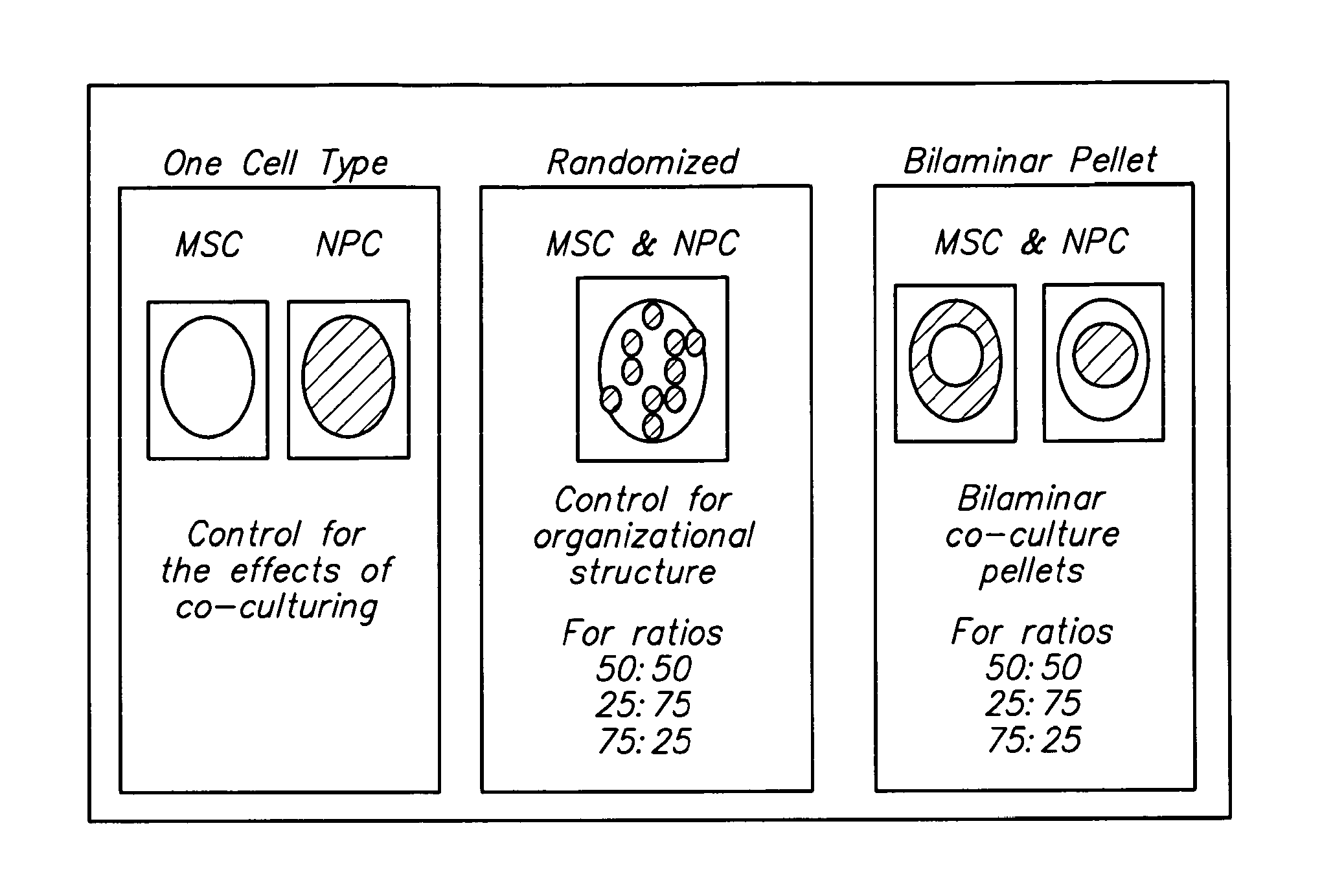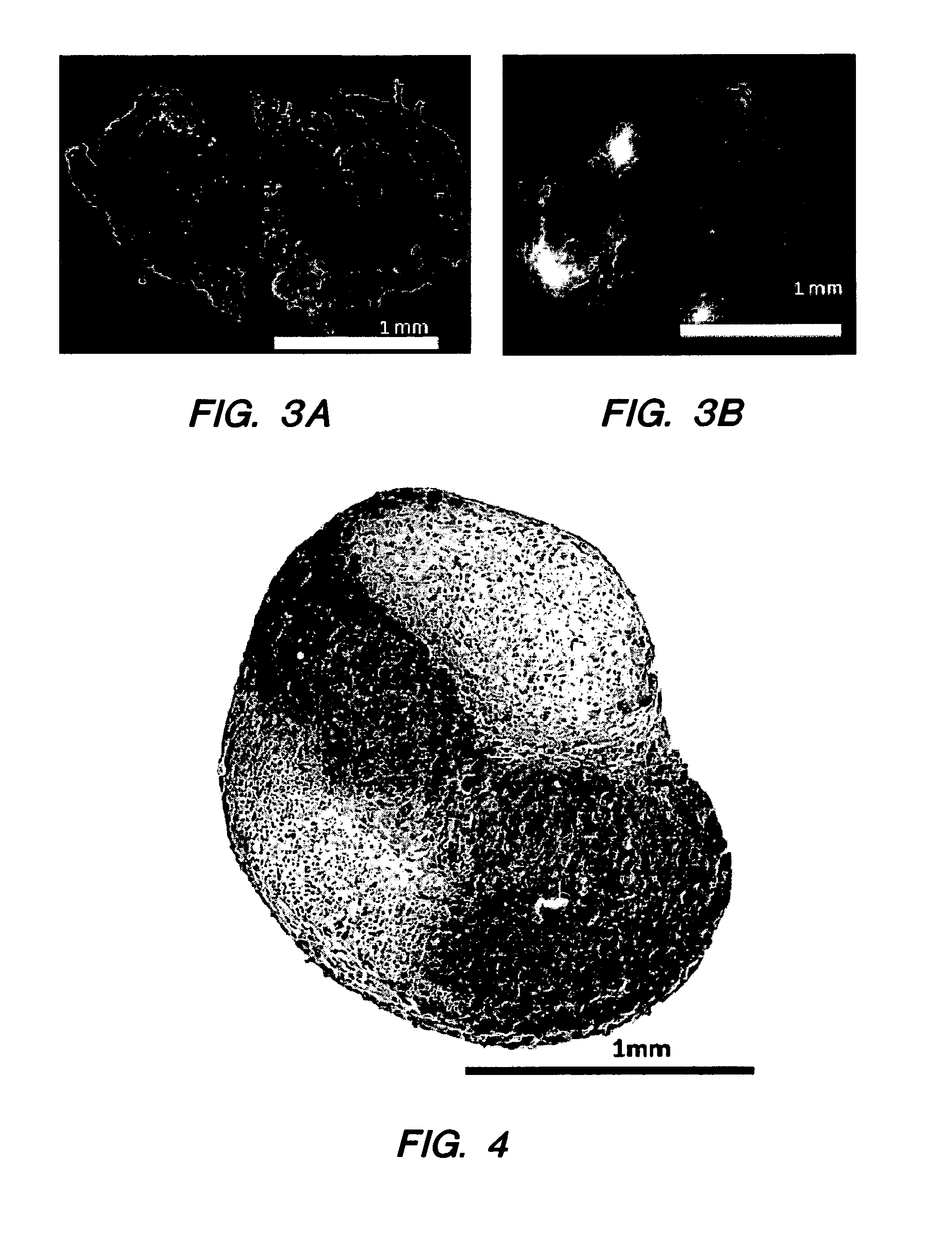Compositions and methods for generating musculoskeletal tissue
a technology of musculoskeletal tissue and compositions, applied in the direction of skeletal/connective tissue cells, drug compositions, biocides, etc., can solve the problems of short-term benefits but also failures after 5-10 years, and a significant number of patients do not benefit from fusion and require further treatmen
- Summary
- Abstract
- Description
- Claims
- Application Information
AI Technical Summary
Benefits of technology
Problems solved by technology
Method used
Image
Examples
example 1
Culturing MSCs in a Bioreactor
[0211]Chondrogenic stimulation: bone marrow-derived MSCs (Cambrex Corp.) were suspended in 1.2% alginate gel at a concentration of 4 million cells / mL; beads were formed by dispensing dropwise into a calcium chloride bath. Beads were cultured in media with chondrogenic supplements and TGF-beta3 for 7 or 14 days.
[0212]Bioreactor assembly: a dialysis cassette (Slide-A-Lyzer, Pierce) was filled with 300 uL of hyaluronan gel and submerged in cell culture media to allow for volume expansion and pressure buildup. An autoclavable porous metal clip surrounds the device to permit fluid exchange but prevent membrane rupture).
[0213]Undifferentiated MSCs or MSCs pre-cultured in alginate beads were suspended in fibrin glue (Tisseel VH, Baxter Corp.) at a concentration of 4×106 cells / mL and a 100 μL pellet was injected into the center of the cassette. Cassettes were cultured in media without chondrogenic supplements for 1 or 2 weeks. In addition to cell viability and ...
example 2
Co-Culturing NPC and MSC
[0218]NPC and adult MSC were co-cultured in a 3-dimensional bi-layer culture system. The 3-dimensional system is a spherical, bilayer pellet with an inner sphere and an outer shell. Human MSC were obtained from a commercial source; NPC were obtained from mature bovine tail discs. One cell type was labeled with DiO. The bilayer pellet was formed in two centrifugation steps. Cells forming the inner sphere were centrifuged in 2 ml culture medium at 400×g for 5 minutes in a 15-ml polypropylene tube. Cells forming the outer layer of the pellet were pipetted into the tube; and the cells were centrifuged at 400×g for 5 minutes. Within 24 hours, the cells formed a rounded pellet that freely floated in the tube. Each pellet included about 5×105 cells.
[0219]Each pellet was cultured for 7 days, 14 days, or 21 days. After 7 days, 14 days, or 21 days, the cells in the pellets were sorted by fluorescence activated cell sorting into MSC and NPC. The sorted cells were assaye...
example 3
Structured Coculture of Adult Stem Cells and Nucleus Cells for Disc Regeneration
Materials and Methods
Cell Culture
[0221]Bovine NPC were isolated from caudal discs of healthy adult cows within 48 hours of sacrifice. The NP tissue was carefully separated by gross dissection and digested in 0.5% collagenase / dispase and 2% antibiotic / antimycotic in low glucose Dulbecco's Modified Eagle Medium (DMEM) at 37° C. for 4-6 hrs with constant stirring. The cells were then plated in tissue culture flasks and expanded to the fourth passage in NPC Media (DMEM with 1% antibiotic / antimycotic, 1.5% 400 m Osmolarity, and 5% Fetal Bovine Serum (FBS)) at 37° C. with 5% CO2. Culture media was changed twice a week.
[0222]Commercially available human MSC were purchased (Lonza) and expanded to the sixth passage in monolayer culture using growth media (DMEM low glucose with 1% antibiotic / antimycotic and 10% FBS) at 37° C. with 5% CO2. Culture media was changed twice a week.
[0223]Human nucleus pulposus samples ...
PUM
| Property | Measurement | Unit |
|---|---|---|
| unit volume | aaaaa | aaaaa |
| time | aaaaa | aaaaa |
| unit volume | aaaaa | aaaaa |
Abstract
Description
Claims
Application Information
 Login to View More
Login to View More - R&D
- Intellectual Property
- Life Sciences
- Materials
- Tech Scout
- Unparalleled Data Quality
- Higher Quality Content
- 60% Fewer Hallucinations
Browse by: Latest US Patents, China's latest patents, Technical Efficacy Thesaurus, Application Domain, Technology Topic, Popular Technical Reports.
© 2025 PatSnap. All rights reserved.Legal|Privacy policy|Modern Slavery Act Transparency Statement|Sitemap|About US| Contact US: help@patsnap.com



